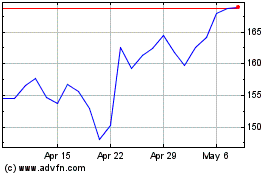By Daniel Michaels
The nuclear power industry is trying to bounce back after
shrinking for decades, and shrunken nuclear reactors could be one
key to success.
Combining new technologies, advanced engineering and a
market-friendly approach, reactor manufacturers are developing new
systems that produce less power but are much smaller and less
costly than existing nuclear reactors.
The pitch: small modular reactors, or SMRs, that can be housed
in compact containment structures and operate safely with less
shielding and oversight. SMRs could allow power plants to shed
their huge hourglass-shaped cooling towers and, in some designs,
the reactors would be immersed in water to prevent overheating.
Dozens of designs are now on the table, with a handful under
preliminary U.S. and Canadian regulatory review following several
billion dollars of investment by private and government entities. A
Utah utility hopes to run the first U.S. SMR by the end of the
decade. China is investing heavily in SMR development, and Russia
last year fired up an SMR on a ship, touting it as a portable power
station.
SMRs may not be an easy sell, given concerns over the safety and
environmental impact of nuclear power. But proponents of the new
technology are pitching competitively priced, potentially limitless
electricity that yields no greenhouse gas emissions -- unlike power
plants that burn fossil fuels -- and that is more reliable than
wind or solar power.
Utilities could retrofit existing power plants by substituting
climate-friendly SMRs for aging, climate-unfriendly coal- or
gas-fired burners, boosters say. SMRs could also power municipal
heating systems, turn water to hydrogen for fuel or electrify
remote locations, all without any emissions.
SMRs would produce up to 300 megawatts of power, compared with
more than 1,000 megawatts for some big power plants now in
operation. But because the devices are inherently modular -- many
of their components can be mass-produced in factories rather than
being constructed on site -- SMRs could be combined in increments
to boost capacity.
"It's not just about making things smaller," says Jay Wileman,
chief executive of GE Hitachi Nuclear Energy, an alliance of
General Electric Co. and Hitachi Ltd. that is developing and
marketing SMRs. "It's about making things simpler."
Like conventional nuclear reactors, SMRs split atoms to heat
water and produce steam, which turns a generator to produce
electricity. Because of their compact size, their proponents say,
SMRs can operate safely with reduced need for the thick shielding,
complex safety systems and intensive maintenance regimens required
for the reactors in traditional nuclear power plants.
A Tiny Nuclear Reactor Could Power Future Space Colonies
By Robert Lee Hotz and Alberto Cervantes
As NASA plans for bases one day on the moon and Mars, agency
engineers know they'll need power -- lots of it. A reliable power
system will be essential for lighting, water and oxygen, as well as
for running experiments and making fuel for the journey home.
NASA is developing a nuclear power plant whose reactor is about
the size of a garbage can. Called Kilopower, this fission power
system could provide up to 10 kilowatts of electrical power
continuously for at least 10 years -- enough to run several
households. Four Kilopower units could sustain a lunar or Martian
outpost.
The high cost of building and maintaining conventional reactors
has stymied the development of new nuclear power plants since the
1980s and led to the decommissioning of nuclear power plants in
many countries.
SMR developers aim to reverse these trends by rethinking reactor
design. It's a bid for industrial survival with overtones of the
Cold War rivalries that can be traced back to the dawn of the
Atomic Age, when President Eisenhower offered his "Atoms for Peace"
plan for the widespread development of nuclear power.
Eisenhower's plan, outlined in a 1953 speech to the United
Nations, ushered in decades of nuclear power plant construction and
a race with the Soviet Union to energize the world. Today, Russia
and China are competing with the U.S. and Europe in the downscaled
market.
Global rivalries are just one concern for reactor makers.
Next-generation nuclear must overcome public wariness of the
technology engendered by the terrifying mishaps at Three Mile
Island, Chernobyl and, most recently, Fukushima. Then there is the
challenge of making a compelling case for nuclear power as the cost
of electricity from natural gas, wind and solar is plunging.
Rather than offering up SMRs as a replacement for renewables,
proponents of the devices say they can play a complementary role in
the smart grid of the future -- replacing coal- and gas-fired
plants and operating alongside wind and solar.
Most utilities rely on a variety of electricity sources, with
differing costs, emissions and capacity to provide the constant
flow that power grids need for stability, says Tom Mundy, chief
commercial officer at SMR developer NuScale Power LLC. "Our
technology is a great complement to renewable power systems," he
says.
The World Nuclear Association, a trade group, has touted "the
enormous potential of SMRs" offered by their small size,
construction efficiency and safety systems, which could in turn
make them easier to finance than conventional nuclear power
plants.
The U.S. government is lending its support to SMR development.
In September, the Nuclear Regulatory Commission for the first time
issued a final safety evaluation report on a SMR -- a critical step
before a design can be approved -- to NuScale. The company, based
in Portland, Ore., and majority-owned by the industrial engineering
and construction multinational Fluor Corp., is developing its first
commercial SMR for utilities in Utah and promising power by the end
of the decade.
Last fall, the Energy Department awarded $210 million to 10
projects to develop technologies for SMRs and beyond, as part of
its Advanced Reactor Demonstration Program. The agency had already
awarded $400 million to various projects since 2014 "to accelerate
the development and deployment of SMRs," it said in a statement on
NuScale's safety evaluation last September.
Dozens of SMR initiatives are at various stages of development
around the world, according to the World Nuclear Association.
Potential buyers range from U.S. utilities trying to phase out
coal-fired generators to Eastern European countries seeking energy
independence.
Estonia, a reluctant part of the Soviet Union for five decades
before gaining independence in 1991, sees nuclear power as a
potential escape from Moscow's continued energy grip. SMRs could
work there because their size best fits the country's power needs,
says Kalev Kallemets, chief executive of Fermi Energia, an Estonian
startup assessing SMR designs for a potential project.
GE, a pioneer in civilian nuclear power, has two main SMR
offerings in the works. The first is a slimmed-down version of the
traditional water-cooled reactor that the corporation has offered
since 2014. GE designers slashed construction costs of the new
device by reducing by 90% the amount of concrete and reinforcing
metal needed, says Mr. Wileman. Rather than relying on electrical
pumps to prevent dangerous overheating in the event of a mishap,
the proposed reactor would be sited below ground in a tank of
water.
Similarly, NuScale's reactor module would rest in a pool of
water and use a safety system consisting of valves instead of
electric pumps, says Mr. Mundy.
GE's second offering, a system now in development with nuclear
startup TerraPower LLC, replaces water with molten salt, similar to
what's used in some advanced solar-power arrays. Dubbed Natrium,
the system runs hotter than water-cooled reactors but at lower
pressure and with passive cooling, which eliminates piping and
electrical systems while improving safety, according to TerraPower
CEO Chris Levesque.
"When you have a really elegant design, you can get multiple
benefits working together," Mr. Levesque says. TerraPower,
established by investors including Bill Gates, received $80 million
of the Energy Department funding for Natrium in October.
While proponents of SMRs tout their inherent "passive safety,"
the small reactors face opposition. Greenpeace, the Union of
Concerned Scientists and other advocacy groups argue that nuclear
power remains a dangerous technological dead-end that causes as
many problems as it solves.
"Small modular reactor development is too slow to address the
climate crisis," the Canadian Environmental Law Association said in
a petition opposing the country's proposed funding of SMRs, which
also criticized SMRs' radioactive waste and cost.
"The basic idea, from a business perspective, is flawed," M.V.
Ramana, a professor of disarmament and global security at the
University of British Columbia, says of SMR technology. Traditional
reactors grew over time to achieve greater efficiencies of scale
and lower cost per kilowatt-hour because power output rose faster
than construction and operating costs. "There's no reason that's
changed," he says, dismissing SMR makers' promises of lower costs
and increased safety. Many proposed SMR expense reductions, such as
less shielding, could ultimately increase their danger, while the
combined use of several modules could create new safety risks like
radioactive contamination that negate gains in individual modules,
he says.
Mr. Ramana also says that the technological advances like 3-D
printing and digital manufacturing that make SMRs possible are
doing even more to improve green renewables. "It's a kind of
treadmill race, where one treadmill is going much faster."
Even the International Atomic Energy Agency, acknowledging
growing interest in the field, concluded last September that
"although SMRs have lower upfront capital cost per unit, their
economic competitiveness is still to be proven."
More From The Future of Everything | Energy & Climate
Explore what's next for energy and the climate.
How Skiing Can Survive Climate Change
From artificial clouds to autonomous snow-grooming vehicles,
here are 12 ways for ski areas to weather warmer temperatures and
less snow.
Floating Wind Turbines Buoy Hopes of Expanded Renewable
Energy
Offshore wind farms that don't need to be embedded in the
seafloor could open up new areas to clean-power generation.
Green Hydrogen Plant in Saudi Desert Aims to Amp Up Clean
Power
Developers behind the world's largest planned green hydrogen
project hope a growing global thirst for emission-free fuels will
pay dividends.
Read the full report.
Write to Daniel Michaels at daniel.michaels@wsj.com
(END) Dow Jones Newswires
February 11, 2021 13:50 ET (18:50 GMT)
Copyright (c) 2021 Dow Jones & Company, Inc.
GE Aerospace (NYSE:GE)
Historical Stock Chart
From Mar 2024 to Apr 2024

GE Aerospace (NYSE:GE)
Historical Stock Chart
From Apr 2023 to Apr 2024
